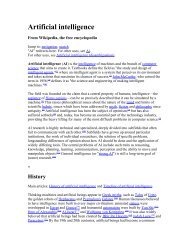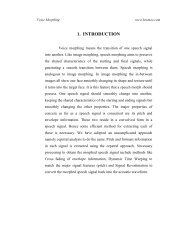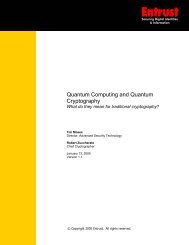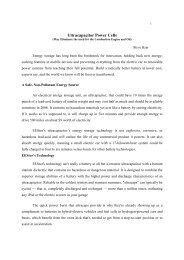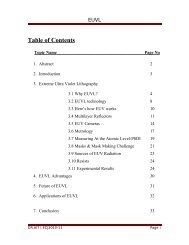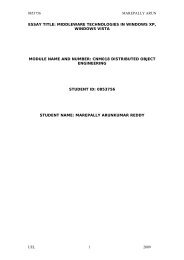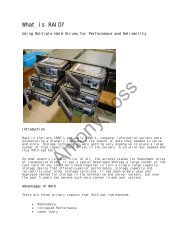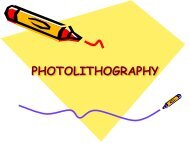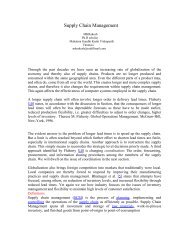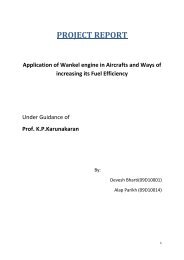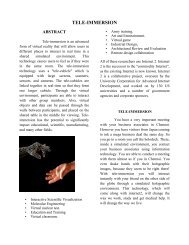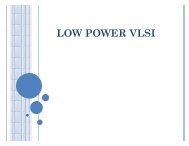Plasmonic organic solar cell.pdf - 123SeminarsOnly
Plasmonic organic solar cell.pdf - 123SeminarsOnly
Plasmonic organic solar cell.pdf - 123SeminarsOnly
You also want an ePaper? Increase the reach of your titles
YUMPU automatically turns print PDFs into web optimized ePapers that Google loves.
4<br />
n<br />
1.8<br />
1.6<br />
1.4<br />
1.2<br />
1.0<br />
0.8<br />
0.6<br />
0.4<br />
0.2<br />
nanospheres appears, which results in a strong decrease of the<br />
transmission and then an increase of the absorptance, at<br />
wavelength 360 nm. Nevertheless, a maximum appears also on<br />
the R curve at l ¼ 375 nm. We can also attribute this small peak to<br />
the surface plasmon, which could cause a decoupling of light in<br />
the plane of periodicity of the NPs grating and an increase of R, as<br />
it was noticed in [15] in similar coupling devices using photonic<br />
crystals. Because our 2D structure exhibits a dual periodicity of<br />
the dielectric constant, it can be considered as a 2D photonic<br />
crystal, but this appellation is usually used for all dielectric<br />
structures.<br />
The diameter of the nanospheres is very small compared to the<br />
wavelengths of the incident waves. Thus, the Mie Theory [16] can be<br />
used to describe the interaction of the incident energy with<br />
the localized plasmons due to the metallic nanoparticles. This<br />
model consists of the rigorous resolution of Maxwell’s equation by<br />
taking both the electromagnetic field inside the NPs and the field<br />
scattered by the NPs into account. The first-order Mie Theory leads<br />
to the expression of the extinction coefficient s(o), also called<br />
‘‘absorption-scattering cross-section’’, of a set of metallic NPs [17]<br />
sðoÞ ¼<br />
9NoV 3=2<br />
s<br />
c<br />
k data<br />
k fit<br />
n data<br />
n fit<br />
0.4 0.5<br />
0.6<br />
Wavelength (μm)<br />
0.7 0.8<br />
Fig. 6. Measured data from [12] compared with our fitted data with a Drude model<br />
(used as input in our numerical method) for optical constants of silver.<br />
A, R, T (%)<br />
100<br />
90<br />
80<br />
70<br />
60<br />
50<br />
40<br />
30<br />
20<br />
10<br />
360<br />
0<br />
350<br />
450<br />
550 650<br />
Wavelength (nm)<br />
2ðoÞ<br />
½ 1ðoÞþ2 sðoÞŠ 2 þ 2 2ðoÞ !<br />
A(Ag)<br />
R(Ag)<br />
T(Ag)<br />
Fig. 7. Calculated values of reflectance (&), transmittance (J) and absorptance<br />
(1 R T) (’) versus wavelength for a square matrix of silver nanoparticles placed<br />
in air. Plasmon resonance at l ¼ 360 nm.<br />
ARTICLE IN PRESS<br />
D. Duche et al. / Solar Energy Materials & Solar Cells ] (]]]]) ]]]–]]]<br />
750<br />
9<br />
8<br />
7<br />
6<br />
5<br />
4<br />
3<br />
2<br />
1<br />
0<br />
k<br />
(2)<br />
where o ¼ 2p/l is the pulsation of the incident electromagnetic<br />
field, c the speed of light in vacuum, es thedielectricconstantofthe<br />
surrounding medium, V thevolumeofoneNP,N the volumic density<br />
of NPs, and e1 and e2 are, respectively, the real part and the<br />
imaginary part of the dielectric constant em of the metal<br />
(e m ¼ e 1+ie 2). It is important to notice that both scattering out of<br />
the NPs and absorption inside the NPs are included in s(o).<br />
According to Eq. (2), s(o) is maximal when<br />
[(e1(o)+2es(o)) 2 +e2 2 (o)] is equal to zero. This condition is called<br />
the Mie resonance.<br />
Thus, assuming that e1 2 be2 2 for frequencies in the Mie<br />
resonance region (typically true for Ag), Mie Theory can predict<br />
the plasmon resonance wavelength of a layer integrating NPs by<br />
using the following formula:<br />
1ðoÞ ¼ 2 sðoÞ (3)<br />
According to Eq. (3) and silver optical constants, we calculate<br />
and obtain the plasmon resonance wavelength at l ¼ 357 nm.<br />
A very close value of that resonance wavelength is observed in<br />
Fig. 7 (l ¼ 360 nm).<br />
In order to highlight and explain the experimental plasmon<br />
effect by numerical calculation, we have calculated values of<br />
(1–R T), i.e. absorptance, versus the wavelength for a squared 2Dgrating<br />
silver nanoparticles placed in the air, for the MEH-<br />
PPV:PCBM interpenetrating network alone, and for silver nanoparticles<br />
embedded in the network (Fig. 8). Even if the Ag<br />
distribution is slightly different in our experiments and in our<br />
calculations, we observe that the main behaviour of the three<br />
calculated curves is similar to experiments curves (see Fig. 3). The<br />
behaviour of the absorptance curve concerning the MEH-<br />
PPV:PCBM alone is in accordance with those of its extinction<br />
coefficient k (Fig. 5), like the value of the energy gap at 575 nm.<br />
The enhancement of the absorptance for samples consisting in a<br />
blend including NPs in comparison with those without NPs is also<br />
clearly observed on a large spectral range (350 nmolo800 nm).<br />
This enhancement is attributed to the localized plasmon effect<br />
due to the metallic NPs. We can also notice that the plasmon<br />
resonance wavelength is redshifted by 95 nm to l ¼ 455 nm in<br />
comparison with the resonance at l ¼ 360 nm of the NPs placed in<br />
air. This result fulfils the Mie Theory of Eq. (2), which shows that<br />
the plasmon resonance depends on the ‘‘difference’’ between the<br />
real part of the relative permittivity of the metal and the relative<br />
permittivity of the host material surrounding the nanospheres<br />
(either air or active blend). The beneficial effect is mainly<br />
interesting in the long-wavelength range 500 nmolo800 nm, in<br />
a spectral region where the MEH-PPV:PCBM absorbs weakly or<br />
A (%)<br />
60<br />
50<br />
40<br />
30<br />
20<br />
10<br />
0<br />
350<br />
400<br />
450<br />
455 575<br />
500<br />
550<br />
600<br />
A(Ag+MEH-PPV:PCBM)<br />
A(MEH-PPV:PCBM)<br />
A(Ag)<br />
Wavelength (nm)<br />
Fig. 8. Calculated values of absorptance A ¼ (1 R T) versus wavelength for<br />
devices: silver nanoparticles in air (’), MEH-PPV:PCBM alone (K), and silver<br />
nanoparticles embedded in MEH-PPV:PCBM (m) showing a resonance at l ¼ 455<br />
nm.<br />
Please cite this article as: D. Duche, et al., Sol. Energy Mater. Sol. Cells (2009), doi:10.1016/j.solmat.2009.02.028<br />
650<br />
800<br />
750<br />
800



